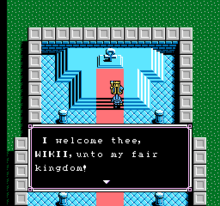Ultima IV: Quest of the Avatar

Ultima IV: Quest of the Avatar, first released in 1985, is the fourth in the series of Ultima computer role-playing games. It is the first in the "Age of Enlightenment" trilogy, shifting the series from the hack and slash, dungeon crawl gameplay of its "Age of Darkness" predecessors towards a moralistic, story-driven approach.
Ultima IV is a rarity among RPGs in that the game's story does not center on asking a player to overcome a tangible ultimate evil. Rather, the object of this game is to become the "prophet" (called "The Avatar") of a new "religion" (or philosophy) for the fledgling land of Britannia (founded on the remains of ruined Sosaria), by understanding and exercising the Eight Virtues of the Avatar, and finding the Codex of Ultimate Wisdom. Richard Garriott has stated that he began writing this game when he realized (partly from letters of enraged parents) that in the earlier games immoral actions like stealing and murder of peaceful citizens had been necessary or at least very useful actions in order to win the game, and that such features might be objectionable. Garriott himself considers this game his most outstanding work, and has released the PC version for free download on the Internet in later years.
Technically, the game was very similar to Ultima III, although much larger. This was the first Ultima game to feature a "conversation system"; whereas NPCs in the earlier parts would only give one canned answer when talked to, now players could interact with them by specifying a subject of conversation, the subject determined either by a standard set of questions (name, job, health) or by information gleaned from the previous answers, or from other characters. Many sub-quests were arranged around this.
Another addition were "dungeon rooms", uniquely designed combat areas in the dungeons which supplemented the "standard" combat against randomly appearing enemies. Also, beginning with this game, an overarching storyline was begun that linked the games more closely together than the thin "new bad guy is the son/daughter of old bad guy" of the earlier games. The world map created for this game remained in use (with a few minor changes) until the last part of the series.
NES version

Like Ultima III, Ultima IV was ported to NES by FCI and Pony Canyon. This version, titled Ultima: Quest of the Avatar, was released in 1990.
The overall game had not been changed much, though the approach was very similar to other console RPGs of the time, particularly Dragon Quest and NES Final Fantasy games.
Graphics had been completely redone, as was the music; the overall graphical and musical tone was close to the feel of the Japanese games. The dialogue options were quite limited once again.
However, the combat system was fairly close to the computer games, with also option to use automated combat.
Ultima IV on modern operating systems
The xu4 project started as a project for playing Ultima IV on Unix-like systems. It was later ported to other platforms including Windows. This requires original Ultima IV for DOS files to run, and keeps compatibility with the orignal DOS version (you can use save files from the orignal DOS game on xu4, and vice versa). The program is currently in beta.
References
- Kasavin, Greg & Soete, Tim (1998). "The Ultima Legacy". GameSpot.
External links
- The Moongates U4 Annex - home of the graphics and music patch, and maps and dialogues for the whole game
- xu4 - modern remake of the game
- Parts 1, 2, 3, and 4 - of the unofficial world text maps originally released simultaneously to when the game went on sale in 1985. Designed to be printed and hung on a wall, these were the most popular maps available at the time for the game
